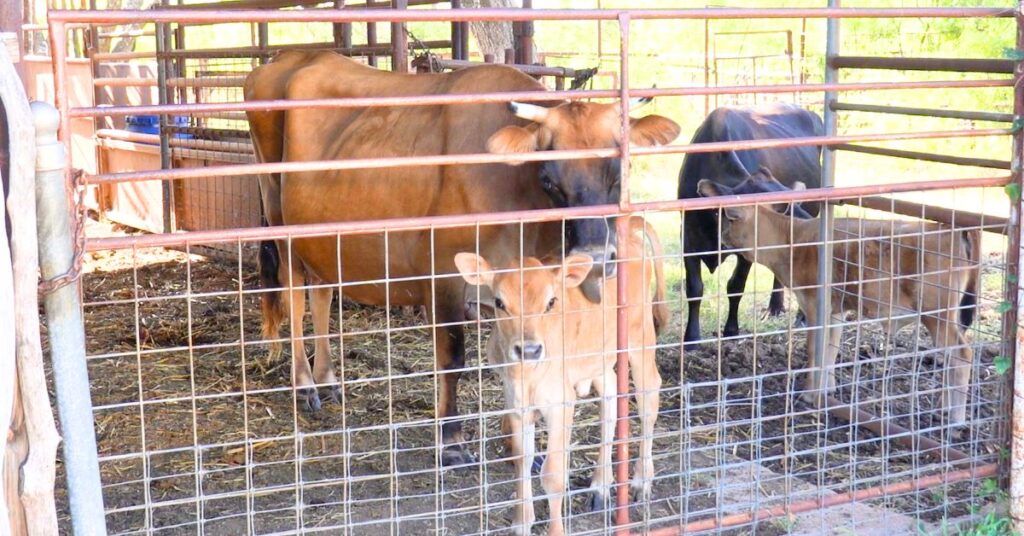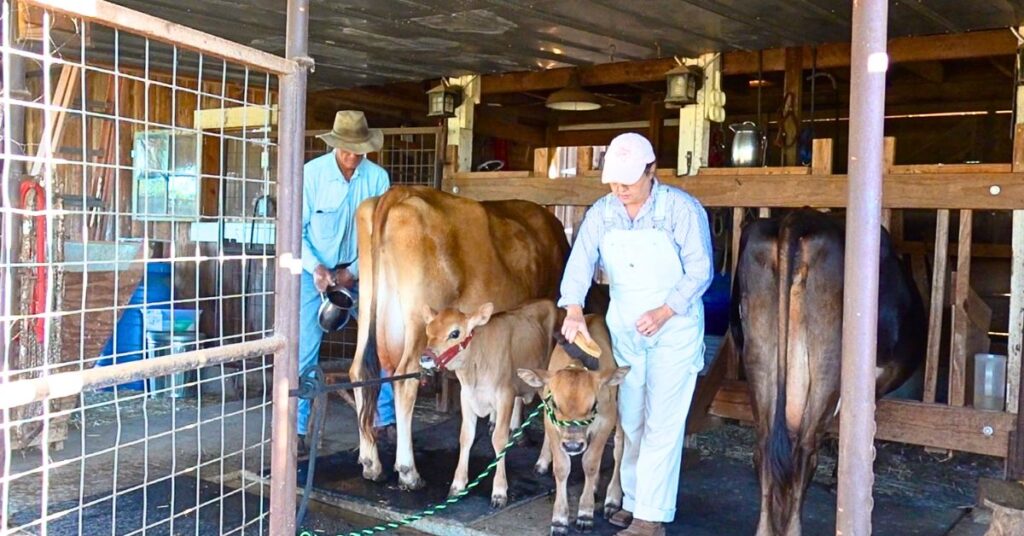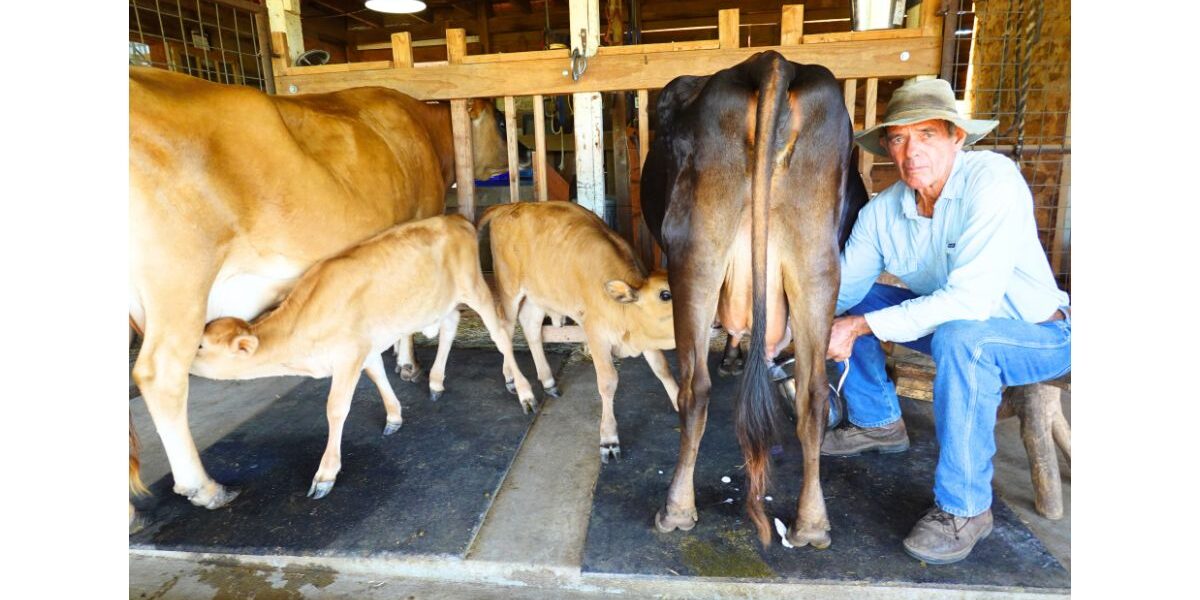Want to know about calf sharing with your family milk cow where everybody is happy. If you have a family milk cow this information will help you make a plan to provide milk for your family as stress-free as possible.

jersey cow and calf are happy when calf sharing
Over the years I had tried many different methods of calf sharing with our family milk cows. Some of them not so good, but as with life we learn from our mistakes. That is the motive for writing this post today. I hope to help you avoid mistakes so calf sharing with your family milk cow will be successful and stress-free.
I know the number one reason you have a family milk cow is to provide nutrient-dense raw milk for your family. So let’s make a plan!
First Decision When Planning to Calf Share with Your Family Milk Cow
Define your goals and make a plan. Make sure the whole family is on board. Family harmony is important here! For example, my goals have evolved over 20 years. Now my holistic goals are to raise heifers to be future milk cows and raise males for beef. Therefore calf health, low stress management, and training are extremely important. The cream line is secondary in the first 7 months because I know in the fall I will produce our dairy products for the winter. We don’t mind giving up a little to raise a vibrant calf raised by the cow.
I went through Holistic Management International training and it will help you define goals and how to achieve them. It all starts with a “Quality of Life Statement”.
Calf Sharing With Our Family Milk Cow
Our cows give birth out in the pasture. The cow and calf are left in the pasture for at least two weeks. We check on them and usually give the cow CMPK paste right after birth in some feed.
After two weeks maybe we will bring in the cow and calf and milk the cow. If the cow is still very protective then we might wait longer. The cow needs to develop a reflex to let her milk down when she comes into the milking parlor. We may go through this routine for several days. Remember this is new maybe for the cow and definitely for the calf. So practice some patience. Calm and stress-free.
You will need to evaluate your cow and make a decision accordingly. You might if the cow and calf aren’t stressed let them spend the night apart maybe after 3-4 weeks. I prefer not to separate until the calf is older and then just a few hours overnight as long as the calf has a herd mate.
When I learned about the importance stress plays in animal health, we do all we can to keep the cow and calf together. At our farmstead we evaluate the situation before we make a decision about separation.
Remember you don’t have to milk if you don’t need the milk so letting the cow and calf stay out in the pasture is perfectly fine. We don’t milk everyday, just when we need more milk. We never milk on church days.
Our goal is for the cow to develop the reflex to let her milk down when she comes into the stanchion for milking so separation won’t be necessary.
Sharing With An Older Calf
Eventually the calf will take all the milk and this usually calls for a few hours away from mom. If the calf is older and with a herd mate they usually don’t mind too much.
One option which is the old fashioned way, is to let the calf nurse on one side of the cow and you milk on the other side. With this option you will get cream. Yeah!

Calf Sharing With Our Family Milk Cow
If the cow won’t let her milk down then you can let the calf nurse for a few minutes before you milk. My cows usually will leave the calf and come into the milking parlor. You also can halter the calf and tie it close to her. This is good training for the calf. If the calf is a bull we do not halter or bring him into the milking area. Remember Jersey bulls can be dangerous and best to raise him to respect humans.
You can milk, then turn them both out to pasture until late evening then separate for the night if so desired. Milk first thing in the morning then turn them out to pasture.
Some Tips If You Separate the Cow and Calf
- Allow fence contact.
- Make sure the calf is in a safe enclosure, there is no protection from the herd.
- The calf will appreciate your attention if she is away from her mother. So spend some time grooming and petting the calf.
- If possible have two calves together so they can have each others company and someone to play with.
- Milk on a schedule and try to milk early because the calf is hungry. Don’t let the calf get overly hungry.
- Do not put the calf in the pen with any natural enemy of bovines. Such as horses, donkeys, or dogs They are instinctive enemies of cows and the cow won’t appreciate you putting her baby in the pen with her foe. I have seen death result from this from people I know.

When Calf Sharing With Your Family Milk Cow the calf and cow will be happy
Some Benefits of Calf Sharing
- The cow and calf are happy therefore less stress = less illness.
- The calf will be healthy which is so very important!
- A cow will teach her calf lots of cow things. A cow will forage for plants that help supply her mineral and medical needs. She teaches her baby.
- Less mastitis-the calf will empty the udder of all the milk which helps deter mastitis.
- An older calf will take every drop of milk from the udder and this encourages milk production.
- You can milk only once a day which is very convenient.
- Going out of town and missing a day of milking is possible.
- You have adequate milk daily and have the Fall to look forward to for butter and cheese.
- You will have a healthy calf to harvest for beef in the fall.
- If you choose not to keep the heifer or harvest the steer calf, you can sell the calf; and you should recover the cost of keeping your family cow.
Calf sharing with your milk cow is the most favorable choice for a healthy cow, calf, and milk! I have seen all kinds of methods and there is always a consequence when they are not together.
Resources to help you calf share with your family milk cow:
- Watch our videos about dairy cows.
- One of the best resources I know for information and asking questions is : Keeping A Family Cow
Important Information to know:
Before Buying A Family Milk Cow Test for these 8 Diseases







